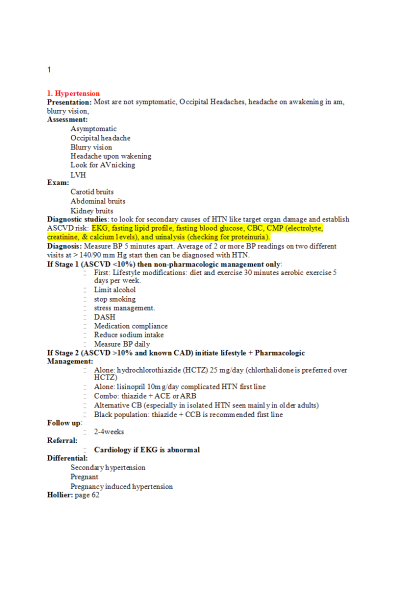NR 667 Week 4 Vise Assignment Study Guide
-
$15.00
| Institution | NR 667 APN Capstone Practicum |
| Contributor | Adam |
- Hypertension
Presentation: Most are not symptomatic, Occipital Headaches, headache on awakening in am, blurry vision,
Assessment:
- Asymptomatic
- Occipital headache
- Blurry vision
- Headache upon wakening
- Look for AV nicking
- LVH
Exam:
- Carotid bruits
- Abdominal bruits
- Kidney bruits
Diagnostic studies: to look for secondary causes of HTN like target organ damage and establish
ASCVD risk: EKG, fasting lipid profile, fasting blood glucose, CBC, CMP (electrolyte, creatinine, & calcium levels), and urinalysis (checking for proteinuria).
Diagnosis: Measure BP 5 minutes apart. Average of 2 or more BP readings on two different visits at > 140/90 mm Hg start then can be diagnosed with HTN.
If Stage 1 (ASCVD <10%) then non-pharmacologic management only:
- First: Lifestyle modifications: diet and exercise 30 minutes aerobic exercise 5 days per week.
- Limit alcohol
- stop smoking
- stress management.
- DASH
- Medication compliance
- Reduce sodium intake
- Measure BP daily
If Stage 2 (ASCVD >10% and known CAD) initiate lifestyle + Pharmacologic
Management:
- Alone: hydrochlorothiazide (HCTZ) 25 mg/day (chlorthalidone is preferred over HCTZ)
- Alone: lisinopril 10mg/day complicated HTN first line
- Combo: thiazide + ACE or ARB
- Alternative CB (especially in isolated HTN seen mainly in older adults)
- Black population: thiazide + CCB is recommended first line
Follow up:
- 2-4weeks
Referral:
- Cardiology if EKG is abnormal
Differential:
- Secondary hypertension
- Pregnant
- Pregnancy induced hypertension
Hollier: page 62 ............ document continue
| Instituition / Term | |
| Term | Year 2022 |
| Institution | NR 667 APN Capstone Practicum |
| Contributor | Adam |


